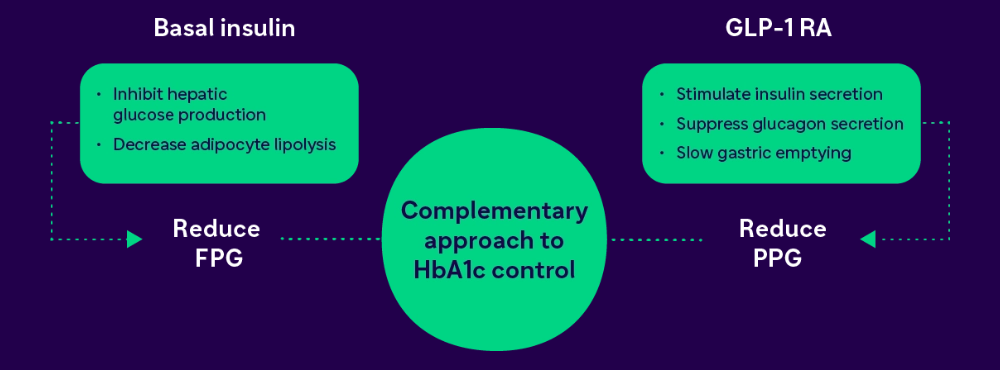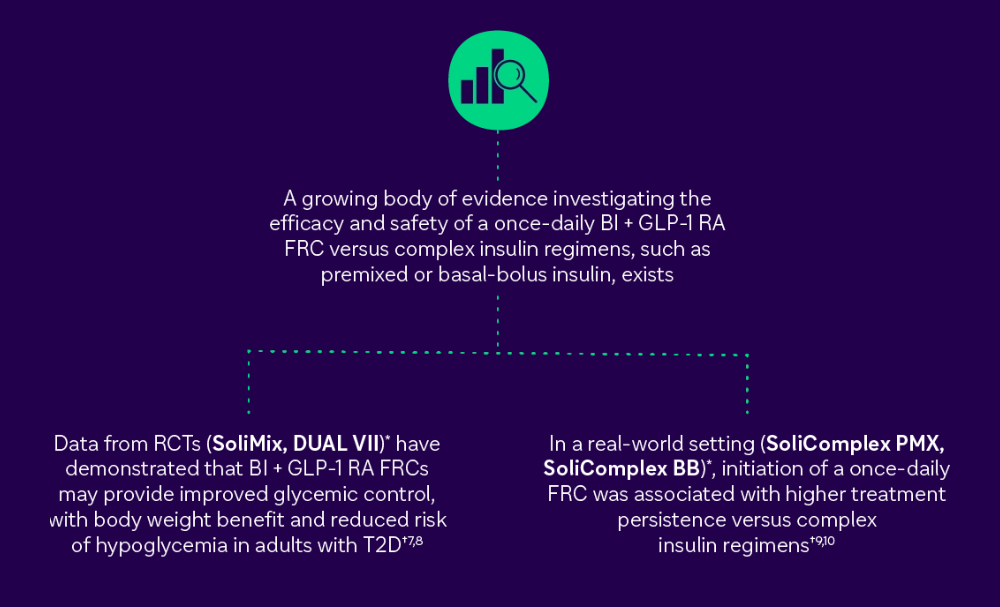Treatment simplification in T2D: A less-is-more approach to help reduce the burden of disease
Treatment burden associated with complex insulin regimens in T2D
- Due to the multiple pathophysiological defects and progressive nature of T2D, many individuals will require therapeutic advancement with insulin-based therapies throughout the course of their lives1
- Therapeutic advancement with complex insulin regimens is often associated with an increased burden of disease, contributing to low treatment adherence and reduced quality of life2
Factors impacting adherence to insulin therapy3

Daily injection
frequency

Injection
embarrassment

Injection
pain

Weight
gain

Hypoglycemia
(and fear of)
- Poor treatment adherence, along with therapeutic inertia, is primarily why people with T2D are experiencing less sustained improvements in a real-world setting compared with RCT data4
- Therapeutic inertia is defined as the failure not only to intensify therapy, but also to de-intensify treatment when people are overtreated5
Simple yet effective strategies are required to help overcome these challenges of treatment burden
Treatment simplification with BI + GLP-1 RA FRCs
- Treatment simplification offers the opportunity to ease disease burden and may help to reduce polypharmacy and risk of hypoglycemia in adults with T2D2
- Current guidelines support the concept of simplification, but primarily focus on the older adult population and lack clear guidance on how this can be achieved1
The combination of a BI analog and a GLP-1 RA may be a simple and effective way to target the multi-faceted manifestations of T2D and may help reduce the burden and complexity of treatment¹
In their main treatment algorithm, the ADA/EASD now recommends BI + GLP-1 RA FRCs as a very high efficacy approach to achieve glycemic goals5
Therapeutic advancement to complex insulin regimens can increase treatment burden for people with T2D, and may be associated with an increased risk of hypoglycemia, reduced treatment adherence and increased body weight
HCPs should regularly assess individual circumstances and needs, and evaluate where it is possible to decrease treatment complexity and the burden of treatment to improve glycemic outcomes on a case-by-case basis
BI + GLP-1 RA FRCs may offer an effective and simple alternative to complex insulin regimens, such as premixed and basal-bolus insulin, to both intensify and simplify treatment
The content of this infographic summarizes key points discussed during an educational video-on-demand with Professor Rory McCrimmon and Dr Alice Cheng. Please note, two FRCs of a basal insulin and a GLP-1 RA are available: iGlarLixi (insulin glargine 100 U/mL + lixisenatide) and IDegLira (insulin degludec + liraglutide).*SoliMix was a multicenter, open-label, randomized study comparing the efficacy and safety of iGlarLixi versus BIAsp 30 in adults with T2D (n=887). DUAL VII was an open-label, two-arm parallel, randomized study comparing the efficacy and safety of IDegLira versus BB in adults with T2D (n=506). SoliComplex was a real-world, retrospective, observational study comparing iGlarLixi and premixed insulin (N=834) or iGlarLixi and BB (N=1070) in adults with T2D advancing on BI. In SoliComplex, data was collected from the US Optum Clinformatics database, therefore the US iGlarLixi pen (Soliqua® 100/33) was administered to participants. †For further details and an overview of the supporting data, please refer to the full educational video-on-demand (MAT-GLB-2204912) and the study publications.
ADA, American Diabetes Association; BB, basal-bolus; BI, basal insulin; BIAsp 30, biphasic aspart insulin 30 (30% insulin aspart and 70% insulin aspart protamine); EASD, European Association for the Study of Diabetes; FPG, fasting plasma glucose; FRC, fixed-ratio combination; GLP-1 RA, glucagon-like peptide-1 receptor agonist; HCP, healthcare professional; PMX, premixed insulin; PPG, postprandial glucose; RCT, randomized controlled trial; T2D, Type 2 diabetes; US, United States.
- American Diabetes Association. Diabetes Care 2022;45(Suppl 1):S125–S143;
- Jude E, et al. Diabetes Ther 2022;13:619–34;
- Peyrot M, et al. Diabetes Care 2010;33:240–5;
- Edelman SV and Polonsky WH. Diabetes Care 2017;40:1425–32;
- Davies M, et al. Diabetes Care 2022;45:2753–86;
- Perreault L, et al. Adv Ther 2019;36:265–77;
- Rosenstock J, et al. Diabetes Care 2021;44:2361–70;
- Billings L, et al. Diabetes Care 2018;41:1009–16;
- Lajara R, et al. Diabetes Obes Metab 2023; doi: 10.1111/dom.14974 (online ahead of print);
- Pantalone KM, et al. Diabetes Spectr 2023; doi:10.2337/ds22-0064 (online ahead of print).


.png/jcr:content/Asset%201@%20(1).png)
.png)
.png)


